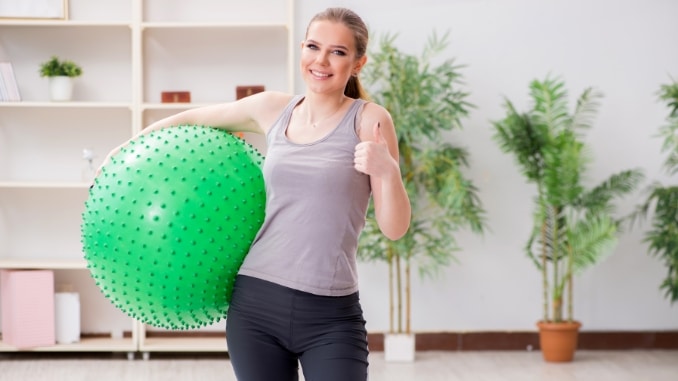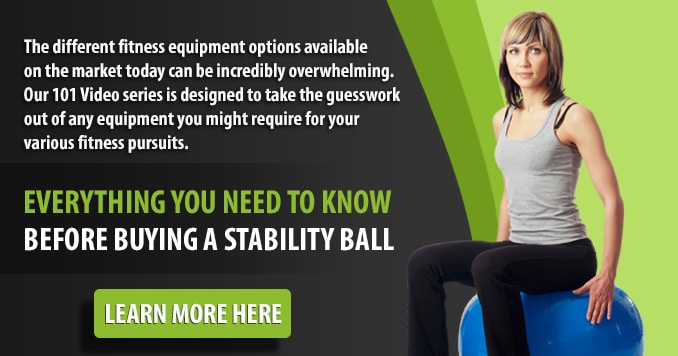Embark on an extraordinary fitness journey with exercise ball workouts using the stability ball. This comprehensive guide offers well-tested exercises to enhance core strength, balance, and flexibility. Expertly curated, each exercise comes with clear step-by-step instructions and progressions for an effective workout. Transform your body's strength, stability, and resilience-guided expertise. The stability ball becomes more than just fitness equipment—it catalyzes personal growth, connecting body, energy, mind, and spirit. Join us for a healthier, stronger, and more empowered version of yourself on this transformative path.
What are Stability Balls Used for?
Stability balls, also called yoga exercise balls, Swiss balls, or balance balls, are flexible fitness tools made from strong, inflatable rubber. They're useful for various fitness and therapy purposes. They help with balance training, building core strength, aiding physical therapy, and rehab. They're used in gyms and at home for workouts. Beyond exercise, stability balls promote better posture, ease stiffness, and offer exercises that strengthen muscles, enhance flexibility, and encourage overall body awareness.
What are the Benefits of Swiss Ball Exercises?
Incorporating stability ball exercises into your routine brings a range of benefits. By embracing this fitness tool, you open the door to a comprehensive approach to overall well-being. These exercises target various aspects of fitness, including core strength, balance improvement, and flexibility enhancement. The unique feature of stability balls, their inherent instability, activates muscles often overlooked in regular workouts. The result? Increased muscle involvement, improved functionality, and a stronger sense of balance. Beyond the scientific aspects, the appeal of stability ball exercises lies in their dynamic and engaging nature, which helps develop a strong, lively, and empowered body over time.
Tips on Buying the Perfect Exercise Ball According to Your Need
The size of the stability ball is crucial for proper usage. To find the right size stability ball, consider your height:
- Under 5'0″: 45 cm exercise yoga ball
- 5'0″ to 5'6″: 55 cm exercise yoga ball
- 5'6″ to 6'2″: 65 cm exercise yoga ball
- Over 6'2″: 75 cm exercise yoga ball
When sitting on the exercise ball, your hips should be level with or slightly above your knees.
1. Quality and Material
Invest in stability balls that are made from durable, burst-resistant materials. PVC(polyvinyl chloride) or rubber are commonly used materials. A high-quality exercise ball should withstand regular use without easily puncturing or deflating.
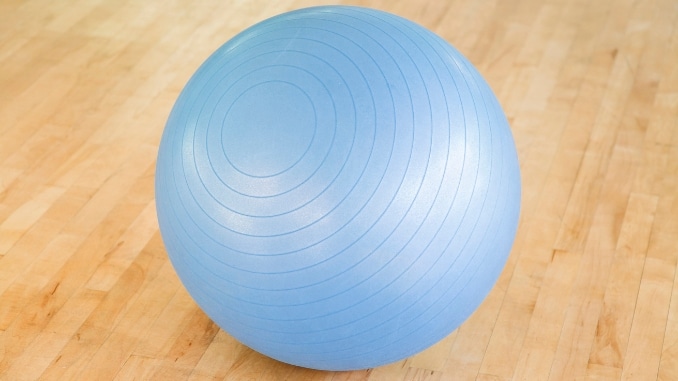
2. Weight Capacity
Evaluate the weight capacity of the exercise ball. It should be able to support your weight without deflating or losing its shape.
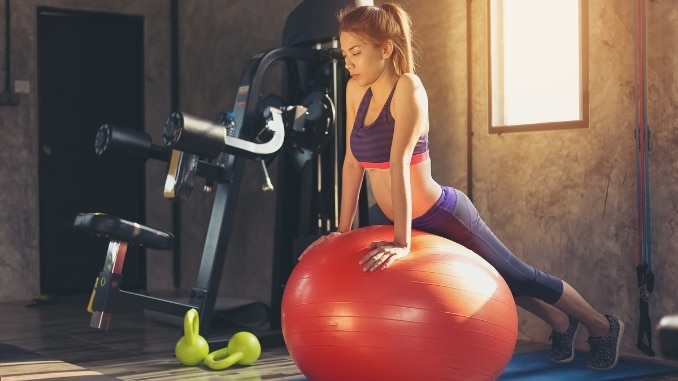
3. Inflation and Deflation
An exercise ball should come with a hand or foot pump for easy inflation. Make sure the ball is easy to inflate and deflate, and it should come with clear instructions on how to do so.
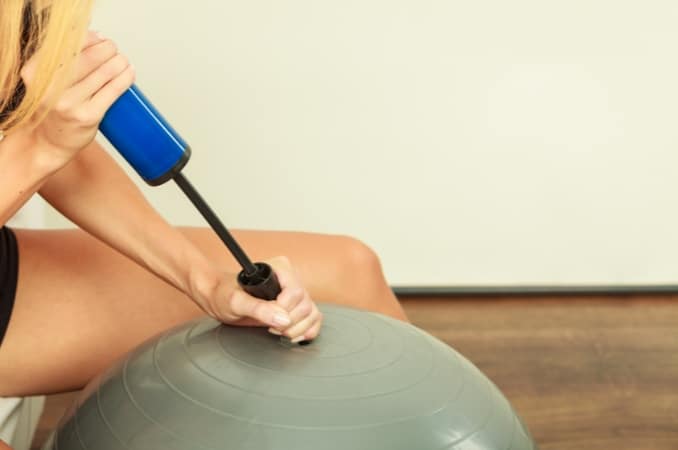
4. Texture and Grip
Most exercise balls come with textured surfaces that provide extra grip and prevent slipping. This can be especially important if you plan to use the ball for exercises that involve lying or sitting on it.

5. Intended Use
Consider how you plan to use the exercise ball. If it's mainly for exercise, look for a ball that suits the types of exercises you'll be doing. If it's for sitting at a desk, consider one with a base or anti-roll feature.
6. Brand and Reviews
Opt for well-known brands that have positive reviews. Reading user feedback can give insights into the ball's quality, durability, and overall performance.
7. Price
While cost shouldn't be the only factor, investing in a higher-quality exercise ball often improves durability and safety.
8. Storage and Portability
If you plan to store or transport the exercise ball frequently, consider its size when deflated and how easily it can be stored.
9. Try Before You Buy
If possible, visit a store to try out different exercise balls. Sit on them, lie on them, and perform some simple exercises to gauge comfort and stability.
10. Warranty
Check if the exercise ball comes with a warranty. A good warranty can provide peace of mind in case the ball has manufacturing defects or other issues.
11. Consult a Professional
If you're using an exercise ball for rehabilitation purposes or have specific fitness goals, consider consulting a fitness professional or physical therapist to ensure you're selecting the right ball for your needs.
Warm-Ups:
1. Hip Rocking
Begin in an upright sitting position on the stability ball with your knees bent and feet flat on the floor. Maintain good alignment with your head, shoulders, and hips. Place your hands on your hips. Engage your core and gently rock your hips from side to side. Repeat the movements.
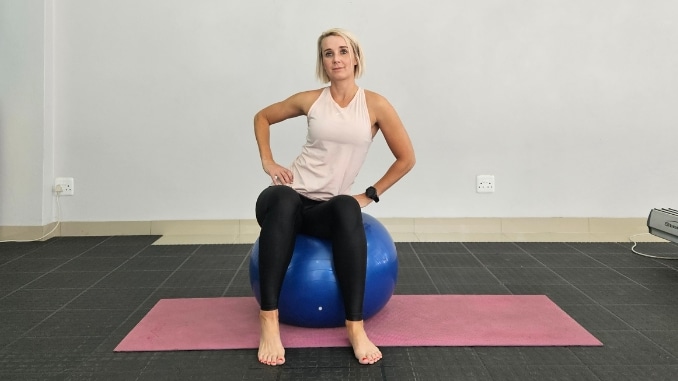 |
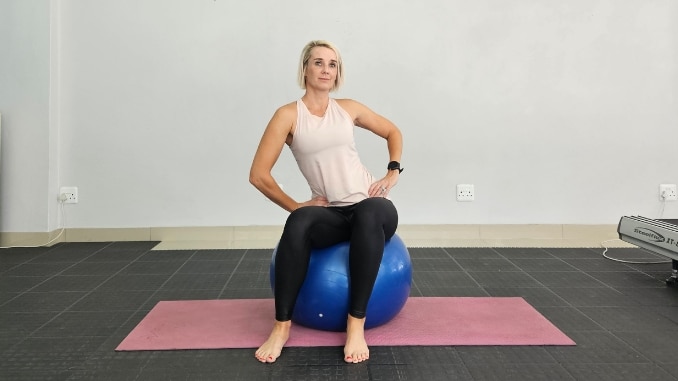 |
Perform the movement for 1 set of 30 seconds to a minute, depending on your fitness and comfort level.
2. Seated Hip Circles
Begin in an upright sitting position on the stability ball with your knees bent and feet flat on the floor. Maintain good alignment with your head, shoulders, and hips. Place your hands on your knees. Contract your abdominal area, then move your hips in a circular motion. Repeat the movement in the opposite direction.
To make this exercise ball workouts easier, widen your stance.
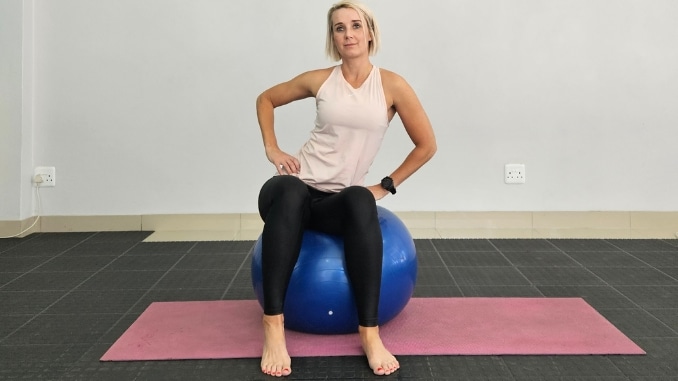 |
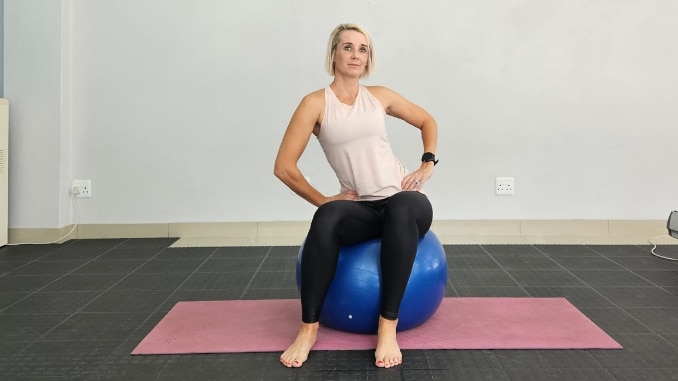 |
To structure your routine for this exercise ball workout, aim for 2-3 sets of 5-10 circles in each direction. Adjust the number of circles based on your fitness level and comfort.
3. Pelvic Rocking
Begin in an upright sitting position on the stability ball with your knees bent and feet flat on the floor. Maintain good alignment with your head, shoulders, and hips. Place your hands on your knees. Engage your core and gently rock the pelvis back and forth in a controlled motion. Repeat the movements.
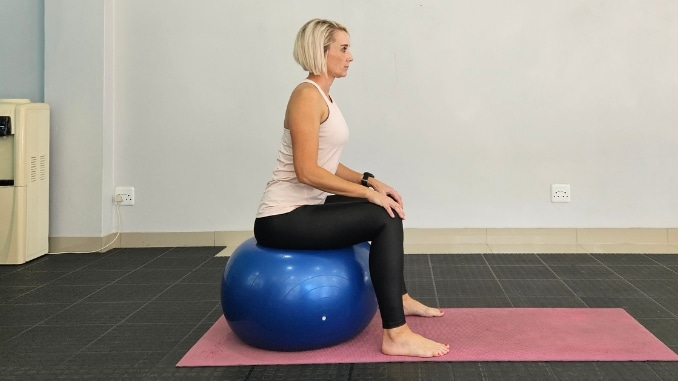 |
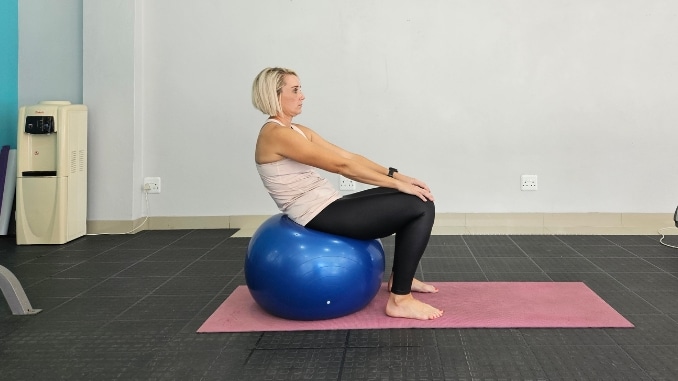 |
Perform 10-15 controlled repetitions of the rocking motion. Focus on the quality of the movement rather than speed.
Best Stability Ball Exercises
Routines:
1. Seated Single Leg Lifts
In this exercise ball workouts, begin in an upright sitting position on the stability ball with your knees bent and feet flat on the floor. Maintain good alignment with your head, shoulders, and hips. Engage core muscles and bend one knee towards your chest, holding for a few seconds. Progress the movement by slowly extending your bent leg forward forward, holding this position for another few seconds. Lower your leg to return to the starting position. Repeat the movement as needed. After several repetitions, perform the movement on the opposite leg.
Perform 2-3 sets of 8-12 repetitions on each leg. You can also increase the duration of each hold.
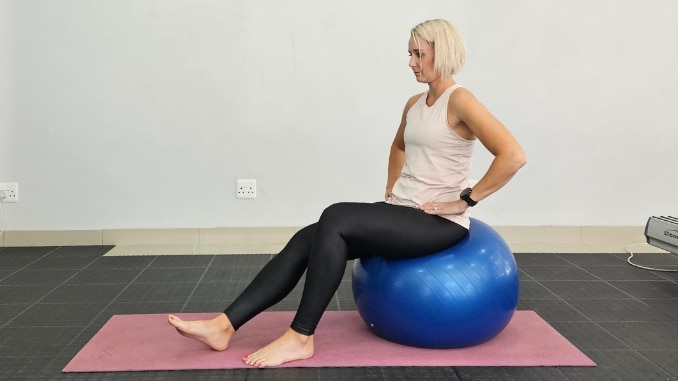 |
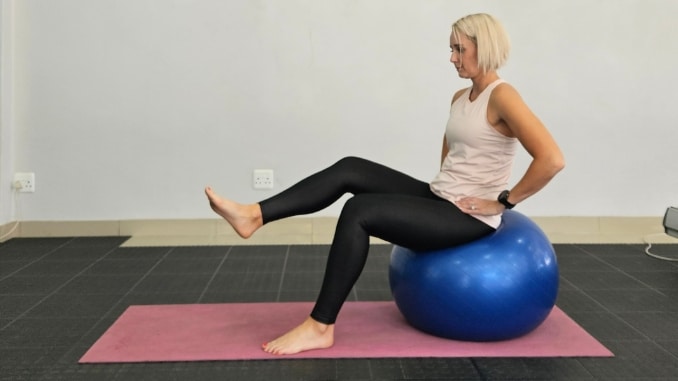 |
2. Squats with Stability Ball
Begin in an upright standing position in front of the stability ball with your feet hip-width apart and your toes pointing slightly outward. Maintain good alignment in your upper body. Bend forward to place both hands on top of the stability ball. Contract your abdominal area, then bend your knees and hinge through your hips to lower your seat into a squat position, pushing the ball forward. Raise back up to the starting position and repeat the movement.
Aim for 2-3 sets of 8-12 repetitions based on fitness level. Perform desired repetitions with controlled and fluid motions. You can also increase squat depth as flexibility and comfort allow.
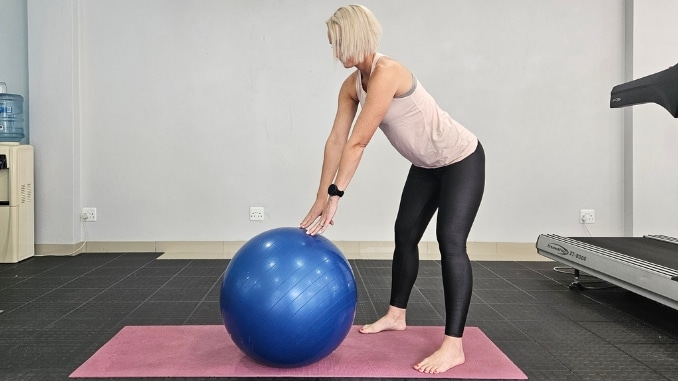 |
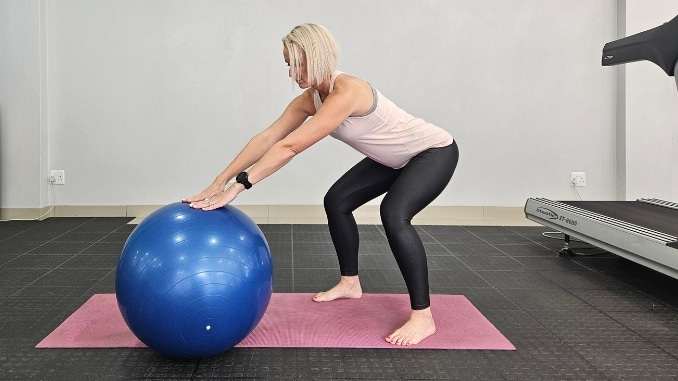 |
3. Ball Squeeze
Begin in an upright standing position with your feet wider than hip-width apart. Place the stability ball between your legs. Engage your core and gently squeeze the stability ball using your inner thigh muscles, holding this position for a few seconds. Relax and release the pressure on the ball in a controlled manner. Repeat the movement as needed.
Aim for 2-3 sets of 12-15 repetitions based on fitness level. You can also choose to increase the duration of the squeeze hold for optimal exercise output.
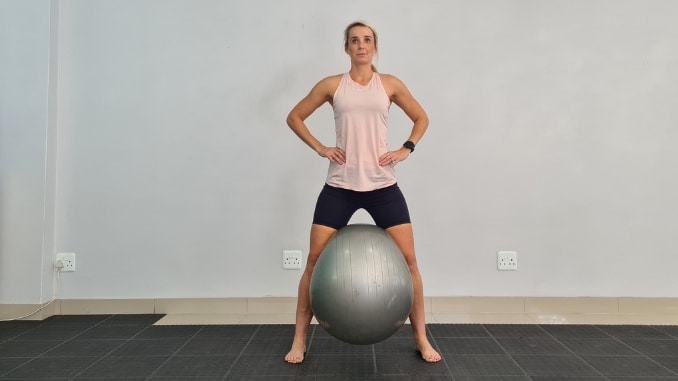
4. Stability Ball Crunch
In this exercise ball workouts, lie on your back on the stability ball with your knees bent and feet flat on the floor. Cross your arms over your chest, maintaining good alignment with your head, shoulders, hips, and knees. Contract your core muscles to slowly roll your upper body forward. Lower your upper body in a controlled movement to return to the starting position. Repeat the movement.
Control the lift and descent, avoiding momentum or neck pulling. Aim for 2-3 sets of 10-15 repetitions based on fitness level. Increase the number of repetitions as your core strength improves.
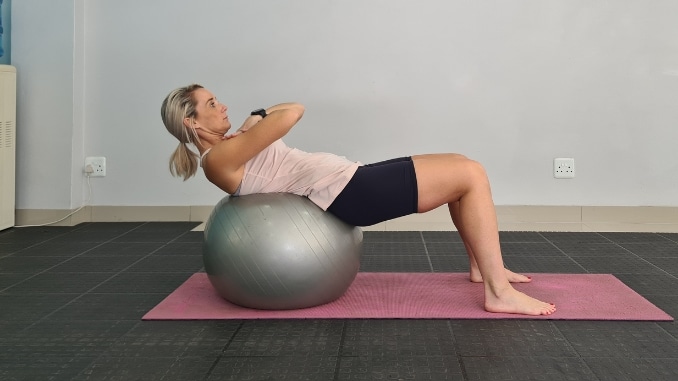 |
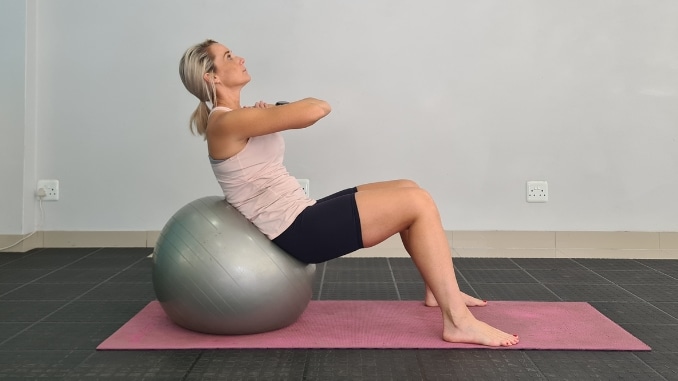 |
5. Stability Ball Chest Stretch
Lie on your back on the stability ball with your knees bent and feet flat on the floor, maintaining good alignment with your head, shoulders, hips, and knees. Engage your core and extend your arms out at your sides, opening your chest up as you let your head fall back. Close your eyes and relax your entire body, taking deep belly breaths for 20-30 seconds. Take deep belly breaths, allowing your muscles to relax into the stretch.
Maintain a comfortable stretch; avoid pushing yourself too far. Keep your back straight and engage your core muscles during the stretch.
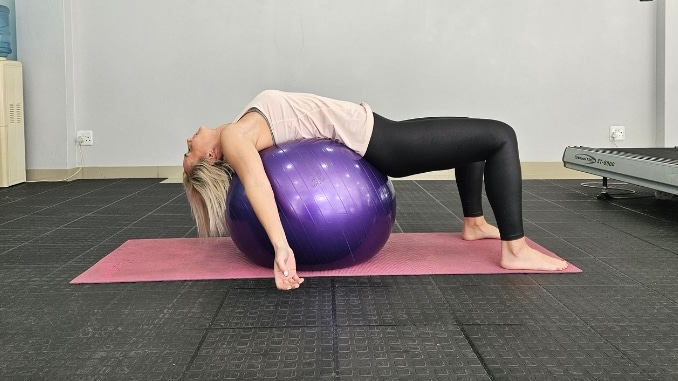
6. Stability Ball Back Extension
Move into a plank position on top of the stability ball with your feet wider than shoulder-width apart, stacking your heels over your toes. Wrap your arms around the stability ball for safety and support. Contract your core muscles and roll your upper body forward, gently rolling the ball forward at the same time. Arch your back to extend your upper body back, focusing on the stretch happening in your lower back area. Return to the starting position by carefully rolling the stability ball back towards your hips, creating a rounded position in your spine. Repeat the movement, creating a gentle rocking motion along your spine with the help of the ball.
Perform the rolling motion for about 1-2 minutes, or as long as it feels comfortable and beneficial. Increase the duration of the exercise gradually as your comfort and flexibility improve.
 |
 |
7. Stability Ball Stir the Pot
Start in an upright kneeling position with the yoga ball in front of your body. Move into a forearm plank position, resting your elbows on top of the ball, and maintaining good alignment with your head, shoulders, hips, and knees. Contract your core and move the yoga ball in a circular motion using your elbows. Repeat the movement in the opposite direction.
Perform the exercise for about 1-2 minutes or as long as it feels comfortable and effective. Gradually increase the duration and difficulty of the exercise as your comfort and core stability improves.
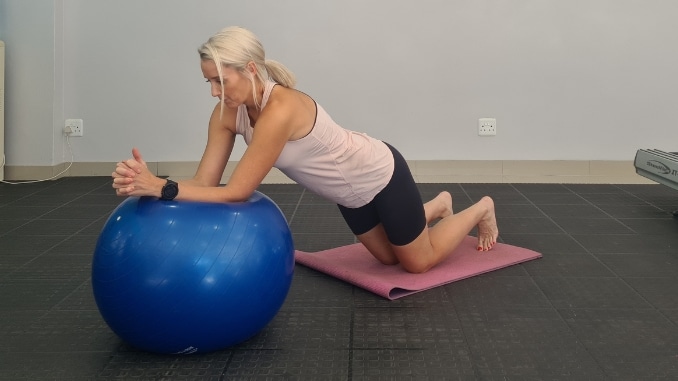 |
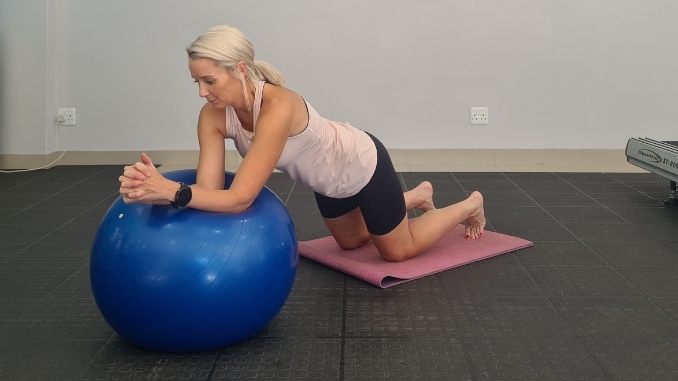 |
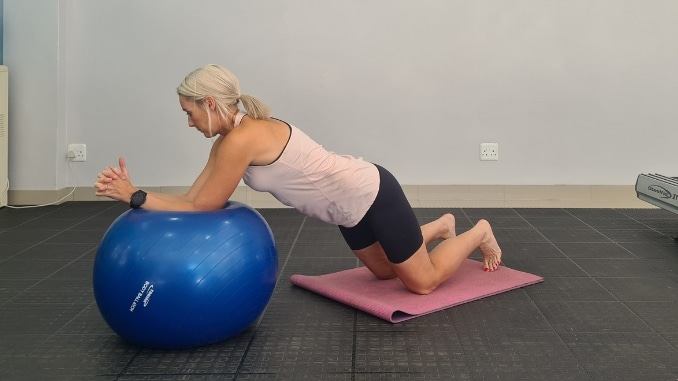 |
8. Wide-Legged Child's Pose with Stability Ball
In this exercise ball workouts, begin in an upright kneeling position in front of the yoga ball with your knees considerably wider than hip-width apart. Engage your core muscles and shift your hips back to your feet while extending both arms on top of the yoga ball. Lower your head between your arms, keeping your upper body parallel to the floor. Hold the position for about 30 seconds to 1 minute or as comfortably as you can hold.
Gradually increase in resistance over the duration of performing the stretch test, as your comfort and flexibility improve. Experiment with arm positioning; try moving arms slightly to the sides for a different stretch.
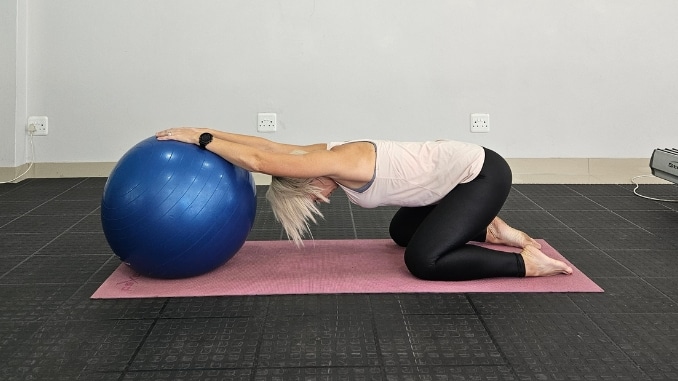
Conclusion
As you bring your Stability Ball Workout with Faye to a close, recognize that this marks the initial chapter of your journey. The stability ball now assumes its role as your unwavering ally on the odyssey to well-being. It embodies boundless avenues for growth, exploration, and triumph. Whether you seek an upgrade in posture, enhanced fortitude, or an invigorated fitness routine, the stability ball stands by as a steadfast companion in your pursuit of fitness ambitions.
Embrace the transfer of knowledge from this exercise ball workouts into your daily endeavors. Allow the accomplishments you've amassed and the wisdom you've gained to infuse empowerment into every stride you take. Relish the sensation of nurturing your physique, breaching limits, and accommodating a lifestyle epitomizing vitality and robustness.
FAQs
1. Are stability ball crunches good?
According to a study conducted by experts from Occidental College in Los Angeles, the answer is affirmative. The research revealed that a person doing crunches on a stability ball (also known as a stability ball or exercise yoga ball) increased the activation or flexing of abdominal muscles by 24 to 38 percent compared to people doing crunches without the ball.
2. Can stability ball exercises induce labor?
No, a stability ball is unlikely to induce labor. Using a stability ball or exercise balls during pregnancy can be beneficial for maintaining physical fitness and promoting good posture. Still, no scientific evidence supports its ability to induce labor. Always consult a healthcare professional for safe methods during pregnancy.
But as per Brichter's insights, assuming a neutral and wide-legged posture while sitting on an exercise or birthing ball readies the body for labor. This preparation occurs through heightened blood circulation, the pelvis's expansion, and cervical dilation stimulation. Additionally, engaging in birthing ball exercises like circular hip rotations, rocking movements, and gentle bouncing can also be advantageous in preparing for childbirth. The rhythmic motion and support provided by the birthing ball can contribute to a more comfortable labor experience.
3. How long do exercise balls last?
The lifespan of an exercise ball can vary based on factors such as the quality of the ball, frequency of use, maintenance, and the weight it regularly supports. A high-quality exercise ball made from durable materials might last anywhere from 1 to 5 years or more with regular use. However, it's essential to remember that over time, the material of an exercise ball can wear down, lose its elasticity, and become more susceptible to punctures.
4. What is an exercise ball chair?
An exercise ball chair is a seating alternative that replaces traditional office chairs with an exercise ball as the seating surface. These chairs have a sturdy frame or base that holds an exercise ball, creating a unique and ergonomic seating solution.
Exercise ball chairs are often used in office environments, home offices, and other work settings where people spend extended periods sitting.

